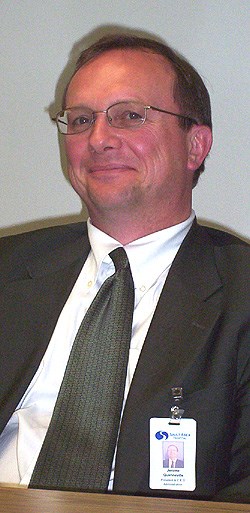The ability to budget for surgeries and services at Sault Area Hospital this year and for another two years is going to mean better service for patients, says hospital CEO Jerome Quenneville.
Quenneville says yesterday's three-year funding announcement by Sault MPP David Orazietti is close to what hospital officials expected for overall amounts, but the multi-year agreement was a nice surprise.
"We're pleasantly surprised that we have some assurances over the next couple of years," said Quenneville. "We're certainly confident that we'll be able to stay on track given this announcement and continue on to follow our balanced budget plan."
"It's encouraging to have the certainty of multi-year funding as we plan ahead," he said. "Here we were at the end of the first quarter of the year and still wondering what our current year level of funding would be and now we know the current year and we have a reasonable number to work with for the next two as well."
Quenneville says that the operating funds Orazietti announced yesterday will not be used to pay off last year's deficit of $5.6 million but will be used to assist the hospital in balancing this year's budget.
He said that last year's $5.6 million deficit has turned into a $9 million challenge to the organization this year after interest was charged on it.
"There are still a lot of changes that need to happen in order to be able to balance the budget," he said.
Quenneville said he also sees opportunities to access more funding over the next few years.
"There's still the opportunity to apply for additional wait time money and additional post-construction operating money for after the new hospital is built," he said.
"There's still an opportunity to address the service changes that are coming in as well as recognizing the difference in the size of the buildings and such."
All hospitals in Ontario, including Sault Area Hospital, stand to gain additional funding if they reduce their wait times for five targeted procedures and submit monthly wait-time reports to the Province, said Dr. Alan Hudson, who is spearheading development of Ontario's Wait Time Strategy.
The five target areas are wait times for hip and knee replacements as well as, cataract, cardiac and cancer surgery and MRI/CT scans.
Hudson was in town yesterday to make a presentation to the Sault Area Hospital Board of Directors and took a few minutes to try it out on the media first.
"One of the biggest problems we've had with wait times in Ontario so far, is that we really haven't known what they are," said Hudson.
Usually surgeon's assistants have that information in their offices but it wasn't getting back to hospitals, he said.
But Hudson and Quenneville both lauded the willingness of Sault Ste. Marie health care professionals to provide the needed data and to take some extreme measures to reduce wait times in the identified areas and across the board.
"It's critical for us to be able to discharge people or get them out of the hospital when it's appropriate," said Quenneville. "Otherwise it does block up beds or availability in the hospital system."
This, Quenneville said, makes patients who need to be admitted to the hospital wait longer in the emergency department and increases emergency wait times.
It also means that surgeons can't do as many operations because there are no beds available for post-operative recovery.
So the Sault Area Hospital works with the Algoma Health Unit, the Group Health Centre, physiotherapists and other area health-care specialists to provide supportive care for people leaving the hospital so they can go home sooner, said Quenneville.
He used the example of the Group Health Centre, CCHC and Sault Area Hospital's initiative on congestive heart failure procedures.
Quenneville said the Sault-based plan and partnership have been used as examples of effective wait time reduction strategizing and teamwork by other agencies and by the Province.
Hudson said that once wait times for the first five focus areas are determined, Ontario's Wait Time Strategy group will set standards for performance and create plans for achieving those standards.
"Essentially, what is needed here is a behavioral change," said Hudson. "There are two tools to change behaviour - money and data."
Hudson said that individual doctors will seek to improve their performance themselves when they see that other doctors are performing better, and hospitals could be financially penalized if standards for wait times are not met.
He also said that wait-time performances by every hospital will be listed on the website by December 2006 and updated monthly thereafter.
